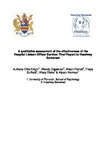A qualitative assessment of the effectiveness of the Hospital Liaison Officer Service: Final Report to Headway Somerset
| dc.contributor.author | Knight, E | |
| dc.contributor.author | Copeman, W | |
| dc.contributor.author | Parrott, A | |
| dc.contributor.author | Norman, Alyson | |
| dc.contributor.other | Headway Somerset | |
| dc.date.accessioned | 2017-11-22T12:47:44Z | |
| dc.date.available | 2017-11-22T12:47:44Z | |
| dc.date.issued | 2017-07-15 | |
| dc.identifier.uri | http://hdl.handle.net/10026.1/10251 | |
| dc.description.abstract |
Whilst there has been an acknowledgement of service inconsistency during a patient’s transition from hospital to home, very few attempts to ‘bridge the gap’ have been made. One of the ways to improve continuity of care and support for the acquired brain injury (ABI) population has involved the development of the Hospital Liaison Officer (HLO) role. Thus, the aim of this study is to explore the effectiveness of the HLO service on ABI patients, their families and healthcare professionals. Qualitative data was collected using questionnaire feedback forms and thematically analysed. Results revealed four main themes from the client dataset; Provision of support, Insight into brain injury awareness, Top-up support, and Negative aspects of the HLO service. Whilst three main themes emerged from the clinical dataset; Provision of support, Insight into brain injury awareness, and Smooth hospital to home transition. Overlapping themes from both datasets were merged together. All themes and sub-themes were discussed in relation to the current literature. Quantitative data of 161 ABI patients, referred to the HLO service over the course of a year, was also collated to be used as descriptive statistics. Whilst the consensus about the HLO roles were positive amongst both datasets, challenges faced by the clients were also explored to highlight areas of potential service improvement. | |
| dc.language.iso | en | |
| dc.title | A qualitative assessment of the effectiveness of the Hospital Liaison Officer Service: Final Report to Headway Somerset | |
| dc.type | report | |
| plymouth.confidential | false | |
| dc.identifier.doi | 10.13140/RG.2.2.10975.36005 | |
| plymouth.organisational-group | /Plymouth | |
| plymouth.organisational-group | /Plymouth/Faculty of Health | |
| plymouth.organisational-group | /Plymouth/REF 2021 Researchers by UoA | |
| plymouth.organisational-group | /Plymouth/REF 2021 Researchers by UoA/UoA04 Psychology, Psychiatry and Neuroscience | |
| plymouth.organisational-group | /Plymouth/Research Groups | |
| plymouth.organisational-group | /Plymouth/Research Groups/Centre for Brain, Cognition and Behaviour (CBCB) | |
| plymouth.organisational-group | /Plymouth/Research Groups/Centre for Brain, Cognition and Behaviour (CBCB)/Behaviour | |
| plymouth.organisational-group | /Plymouth/Users by role | |
| plymouth.organisational-group | /Plymouth/Users by role/Academics | |
| dc.rights.embargoperiod | Not known | |
| rioxxterms.versionofrecord | 10.13140/RG.2.2.10975.36005 | |
| rioxxterms.licenseref.uri | http://www.rioxx.net/licenses/all-rights-reserved | |
| rioxxterms.type | Technical Report |


